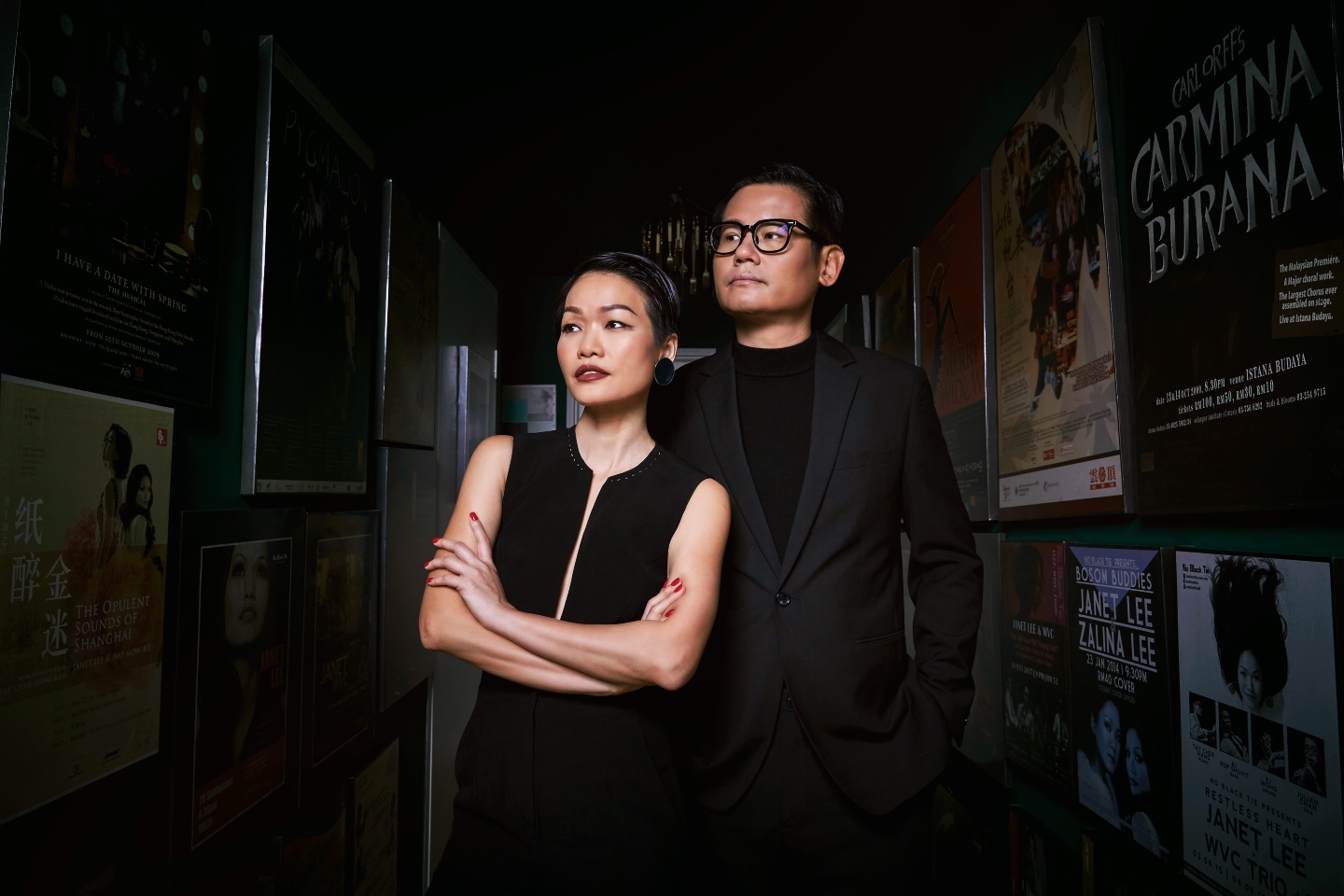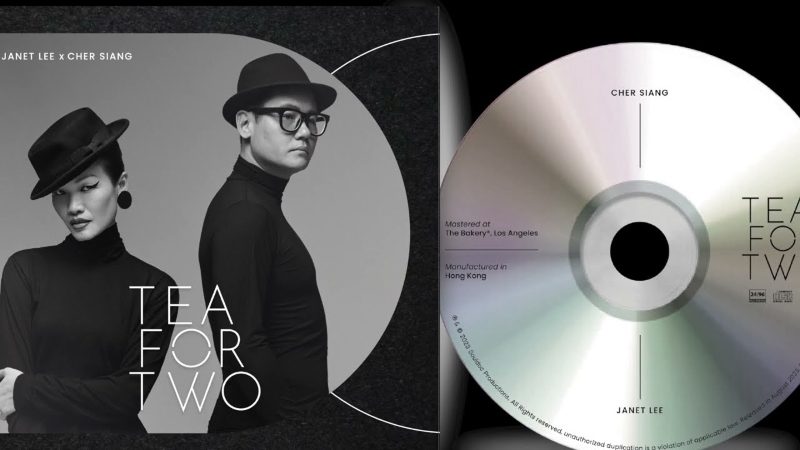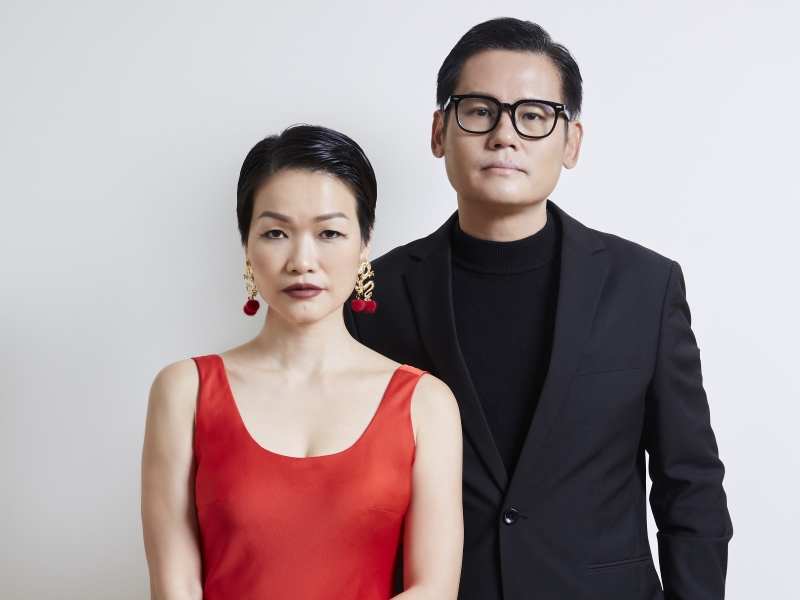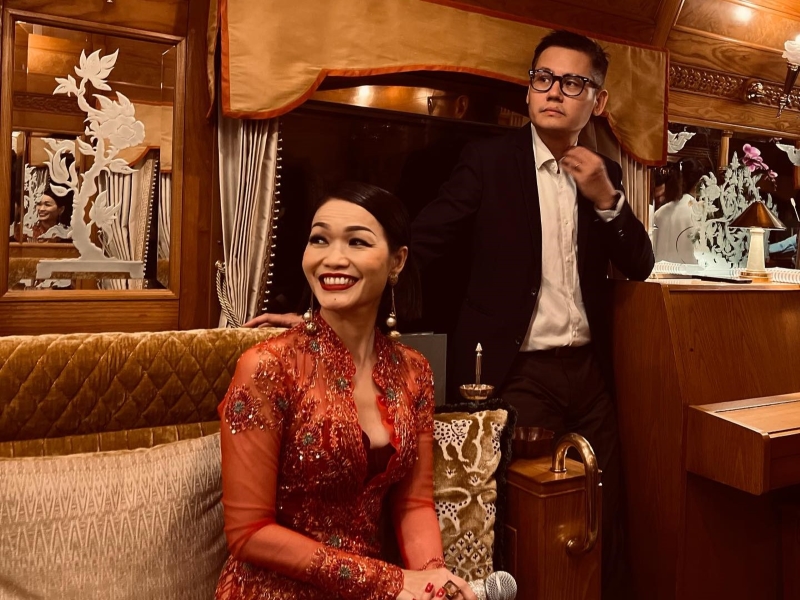
Lee and Tay first met 17 years ago (Photo: SooPhye)
Stepping into the apartment of jazz songstress Janet Lee, it is immediately clear that creativity knows no bounds within these walls. As you cross the threshold into her cosy abode, your eyes are drawn to bookshelves covering an entire wall while bright and quirky artworks adorn others.
Along the corridor leading to the bedrooms, you are greeted by a kaleidoscope of colours and memories plastered on the walls in the form of posters from her electrifying performances. Each poster narrates tales of jazz-filled nights, capturing the essence of Lee’s magnetic stage presence across Kuala Lumpur’s iconic venues like the now-defunct No Black Tie in Bukit Bintang and The Attic in Jalan Bangkung, Bangsar.
Lee, who celebrated her 47th birthday recently, is in the midst of getting her make-up done and hair meticulously styled for our photo shoot and her energy is infectious as she flits between the living room and bedroom. Seated at the dining table, her comrade — pianist, composer and arranger Tay Cher Siang (46) — cuts a stark contrast. His demeanour is serious and focused.
“He’s been like that since I first met him some 17 years ago,” Lee shrugs. “I did ask him about it, and he said it’s just his expression.” She chortles.
Despite his quiet mien, Tay exudes intelligence and a sharp wit, embodying a steadfast presence alongside Lee’s vibrant energy. From the get-go, you learn about his deep passion for jazz and he can go on about the technicalities of it. After all, he holds a master’s degree in jazz pedagogy and has taught at several local universities and the Yamaha Music Academy.
Rojak jazz
Jazz was a foreign concept in the environment where Tay grew up. Perhaps only some commercial jingles caught his attention, such as McDonald’s Moon Man mascot singing Mack the Knife, a song about a killer used to sell hamburgers, or unavoidable Kenny G tunes. However, it was bossa nova that captivated his interest in jazz.
“While walking down Jalan Bunga Raya in Melaka, I stumbled upon an old record store playing Corcovado by Astrud Gilberto. Instantly drawn to the sound, the 15-year-old me was enchanted by Gilberto’s imperfect voice, the nylon strings guitar rhythm and the velvety tone of Stan Getz. Entering the store, I asked the shopkeeper to reserve the CD, which turned out to be Verve Jazz Masters 53: Bossa Nova. This album became the gateway into the world of jazz, Brazilian music, improvisation, rhythm and more,” he recalls fondly.
How does being Malaysian influence his approach to jazz?
“For me, it means embracing a multicultural reality where my daily life is a blend of diverse influences. From the morning azan (Muslim call to prayer) signalling the start of my day to Chinese oldies blasting from the radio as my mom prepared meals, and passing by shops playing music from different cultures on my way to school, I’ve been immersed in a rich tapestry of sounds and traditions.”
Watching Hindi films with his great-grandmother introduced him to the world of Hindi music, while exposure to pop songs from the US, the UK, Hong Kong, Taiwan, Japan, Jamaica, Colombia and beyond broadened his musical horizons.
tea_for_two_album.jpg

“When I play or compose music, I am greatly influenced by this eclectic mix, creating a fusion that I like to call cham cham jazz.”
He likes to refer to his music as “rojak” jazz, originating from New Orleans — an American port city known for its multicultural influences — which serves as a foundation rooted in the black experience yet open to absorbing various musical styles over time. Drawing a parallel to democracy, he suggests that while there are core principles, each society adapts and interprets them differently.
Tay likens jazz to rojak, a salad composed of a mixture of sliced fruit and vegetables served with a spicy palm sugar dressing, as it symbolises the blending of different components to create something unique. In his music, he incorporates elements from multiple sources such as Malayan tunes, Hindi film songs, Shanghai classics, Teresa Teng’s melodies and poetry from different cultures, including Japanese, Shakespeare sonnets, and Song and Tang dynasty poems.
“Similar to the diverse ingredients in Malaysian cuisine that combine to create delicious and unique dishes, I enjoy blending various elements to craft our distinct brand of Malaysian jazz. For instance, I mixed The Girl from Ipanema with The Girl from the South Sea, a Malaysian song, symbolising two beautiful ladies from the Southern Hemisphere gazing sadly at the sea, one in a bikini and the other, a sarong.
“In the same way, with The Shang Sisters, we fuse One Small Umbrella, a popular Hokkien song from the 1980s, with Singin’ in the Rain from the 1950s. The essence of cham music, however, may not be fully appreciated by those from other countries, as Malaysians have the unique ability to sing along to songs in multiple languages like Malay and English and dialects such as Mandarin, Cantonese and Hokkien.
When asked about the jazz scene in this country, Tay replies: “One thing for sure, more young people are interested in various forms of jazz. There seems to be an increase in live venues featuring this [type of] music, and some of them actually flourished over the years. We sometimes tend to think that Malaysia has no art, it is an artistic desert, but I beg to differ. There are many people working in music, and without the safety net of government-assisted art organisations like in First World countries, a number of musicians are surviving solely on their own talents, tenacity, perseverance and creative thinking.”
He doesn’t believe jazz or any form of it would ever become mainstream.
“Jazz musicians usually don’t really try hard to appeal to mass-market tastes, but if somehow their music becomes popular, so be it. If it doesn’t, it’s fine. This sentiment is not unique to Malaysia, it’s a global phenomenon. Jazz has historically been a niche interest even in major cities, thriving on its exclusivity and fostering a sense of camaraderie among insiders, akin to independent films, high literature, avant-garde arts and the like.”
s1a9797aa.jpg

Tay admits that the music they play is not going to appeal to the mainstream audience (“We can’t really cari makan”) and there might be misconceptions about what jazz is.
“For example, clients express interest in having this genre at their events, but when we play slightly more authentic jazz, they request we play something else. I’m not crushed by these hurdles,” he states matter-of-factly.
Instead, he chooses to strike a middle ground of educating clients on jazz, while sneaking in some genuine beats. “We try our best to bring joy and a memorable experience to the audience with our music, that’s how we overcome the challenges.”
Tay observes a growing appreciation for jazz among Malaysians. More people are willing to invest in live music, jazz albums, seminars, talks, merchandise and other related activities, indicating a burgeoning interest in the genre within the country.
“Jazz should be the national music of Malaysia: It is democratic, it is made up of various cultures, it is cham cham. It is always about listening to each other while contributing to the conversations, it is about bringing to the table the best of what you’ve got, it is always about serving the music as priority without being too egoistic. The spirit of jazz should be how we live and interact with each other as citizens in this country.
“As much as I could, I would bring the music to every corner of the country, share my thoughts, ‘preach’, bring joy to people and educate. I write articles, host a weekly radio show, put out albums and do interviews, all to share the good news about jazz. We don’t really have pure jazz singers so to speak, but there are several notable young ones who are doing great things: Jo Lixian, Clinton Chua, Izen Kong and Jessica Teh,” he says, rattling off a diverse list when asked about his musical influences, both in and outside jazz.
In its realm, he cites luminaries such as Bill Evans, Oscar Peterson, Brad Mehldau, Herbie Hancock, Miles Davis, John Coltrane, Jan Garbarek, Kenny Barron, Brian Blade, Lyle Mays and Uri Caine. In the classical domain, he draws inspiration from the works of Mahler, Bach and Brahms. Beyond jazz and classical, his influences extend to rock legends like Jimi Hendrix and The Beatles, as well as modern icons such as Radiohead and Bjork. Additionally, he acknowledges the impact of Asian musicians Yao Min, Chen Gexin, Jonathan Lee and seniman agung Tan Sri P Ramlee, along with world music figures like Antônio Carlos Jobim, Misha Alperin and Huun-Huur-Tu.
Tay has a few performances lined up in the next few months, while also performing about once a month with Lee on the back-on-track Eastern & Oriental Express.
“I am working on the ‘Lagu Raya’ project with Marina Tan and Aziz Salim, slated to premier on May 5 at Temu House. This is going to be a music + narration, exhibition and storytelling project. We are also playing at Jaotim KL on May 15 and 16.
“The inaugural Royal Selangor Jazz Festival on July 14 will feature various acts with 17 bands jamming throughout the day. I am proud to be the fest curator. Janet will perform with my band WVC Jazz at the Permaisuri Zarith Sofiah Opera House in Johor Bahru on Aug 25.”
There is so much to look forward to and that makes him one happy jazz singer.
tay_cher_siang_janet_lee.jpg

The songstress speaks
Lee’s foray into jazz started long before she even knew the name of the genre.
“When I first heard Natalie Cole’s 1991 album Unforgettable: With Love on my sister’s Walkman with headphones on, the sensation was incredible for my teenage ears. The novelty of the big band sound and her silky yet effortless vocals drew me in instantly. I suppose you could say it was love at ‘first sound’.
“Perhaps my entry into this genre was what we’d call smooth jazz. It opened the door to a universe of artsy philosophy. Since then, I have grown to like other sounds of the music and my ears are very receptive. No matter the type, jazz always has this effect of ‘I am home’ when I’m in it, whether I am listening to a live performance or recording, or performing it. The music’s philosophy of bottomless imagination and creativity as well as its old-school and romantic qualities ground my restless heart.”
The list of her influences has evolved over time as she ages.
“In my earlier days of listening and expanding my repertoire and stage personas, I soaked up many recordings and clips of live performances by Grace Chang (Ge Lan), Liza Minnelli, Barbra Streisand and Carol Burnett. And there were also Mia Palencia and Roger Wang’s albums playing on repeat, as well as ensembles like Brand New Heavies, Incognito and The Manhattan Transfer.”
Later on, her palate shifted towards artistes like Katie Melua, Bernadette Peters, Mel Tormé, Kurt Elling and Bill Evans. Nowadays, she finds inspiration from the sounds and work of contemporary singers such as Jacob Collier, Lady Gaga and Miley Cyrus. A few rising jazz acts that she enjoys listening to and watching are local band Kangkung Belacan, singer Angela Ong and vocal trio Pop n’ Bop.
The jazz scene in Malaysia has undergone significant evolution over the years. Recalling the days of the Sunrise Jazz and Rhythm Festival at Plaza Mont’Kiara in the mid-2000s, Lee says it was a prominent event that garnered much attention, even among non-jazz enthusiasts. Since then, numerous other festivals have emerged, both in Peninsular Malaysia as well as Sabah and Sarawak, providing local musicians with additional platforms to showcase their work.
“There are now many live venues that programme jazz jamming sessions on their calendars on a regular basis. Whenever I have time to look up from my full plate of projects, I am delighted by new, young acts and new projects by my comrades on the scene. I think live music, on the whole, has truly flourished and grown … whether or not we have garnered a bigger audience, there is definitely more interest in making music, jazz and then some.”
What’s it like being a jazz singer in Malaysia?
“This might sound a little insular, but I speak from personal experience. I work in a rather compact and cosy environment on the jazz circuit, with event organisers, festival producers and clubs. The opportunities have been abundant for my colleagues and I, and the freedom to play what we like is there. Sure, there were times when I was told that a booking had gone to a pop act or an international artiste instead of us. I see these as reminders that we will inherently face competition or distraction from all directions.”
According to Lee, jazz is a wholesome art form that enables people of all ages to connect, stimulates and even serves as a form of catharsis.
“I view my active live performance calendar as an ongoing, soul-enriching and therapeutic experience, in addition to being a career. Beyond simply promoting jazz as a genre, releasing new albums and performing, I recognise that I am advocating for something wholesome to fellow performers and audiences alike: creating a supply of music and arts to stimulate demand. Encouraging people to attend live performances fosters a community and society unafraid to express themselves and connect with others through shared interests.”
When asked about any memorable performances or collaborations, she reflects on her recent experience with The Shang Sisters and WVC Jazz at the Petaling Jaya Performing Arts Centre (PJPAC) in Selangor. With less than two months to prepare, they faced the challenge of completing all technical rehearsals and the concert itself in just one day. Despite the tight timeline, they managed to sell out the show, thanks to funding and support from the Ministry of Communications.
The collaboration also involved the guidance of thespian director and screen veteran Nell Ng, who worked alongside them as show director, as well as a dedicated ensemble of college students who served as both crew members and performers.
One can’t deny the strong local influence on her approach to jazz. Describing Malaysians as earnest people, she sees herself and her peers in music, whether jazz or other genres, as authentically rojak and proudly embracing their multicultural influences while making music.
“Being a Malaysian musician and performer entails having a multilingual repertoire and embracing the musical idiosyncrasies of the diverse cultures that shape our everyday landscape. Elements from both the East and West influence my songs and performance quirks.”
And just like that, she’s off to pose for the camera, embodying the versatility of a chameleon and the artistry of a performer, all while Tay maintains his cool composure.
This article first appeared on Apr 29, 2024 in The Edge Malaysia.


